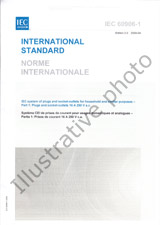We need your consent to use the individual data so that you can see information about your interests, among other things. Click "OK" to give your consent.

IEC 61000-4-5-ed.3.0
Electromagnetic compatibility (EMC) - Part 4-5: Testing and measurement techniques - Surge immunity test
STANDARD published on 15.5.2014
The information about the standard:
Designation standards: IEC 61000-4-5-ed.3.0
Publication date standards: 15.5.2014
SKU: NS-412162
The number of pages: 155
Approximate weight : 496 g (1.09 lbs)
Country: International technical standard
Category: Technical standards IEC
The category - similar standards:
Annotation of standard text IEC 61000-4-5-ed.3.0 :
IEC 61000-4-5:2014 relates to the immunity requirements, test methods, and range of recommended test levels for equipment with regard to unidirectional surges caused by over-voltages from switching and lightning transients. Several test levels are defined which relate to different environment and installation conditions. These requirements are developed for and are applicable to electrical and electronic equipment. The object of this standard is to establish a common reference for evaluating the immunity of electrical and electronic equipment when subjected to surges. The test method documented describes a consistent method to assess the immunity of an equipment or system against a defined phenomenon. This standard defines a range of: - test levels; - test equipment; - test setups; and - test procedures. The task of the described laboratory test is to find the reaction of the equipment under test (EUT) under specified operational conditions to surge voltages caused by switching and lightning effects. It is not intended to test the capability of the EUTs insulation to withstand high-voltage stress. Direct injections of lightning currents, i.e. direct lightning strikes, are not considered in this standard. This third edition cancels and replaces the second edition published in 2005, and constitutes a technical revision which includes the following significant technical changes with respect to the previous edition: - a new Annex E on mathematical modelling of surge waveforms; - a new Annex F on measurement uncertainty; - a new Annex G on method of calibration of impulse measuring systems; and - a new Annex H on coupling/decoupling surges to lines rated above 200 A. Moreover while surge test for ports connected to outside telecommunication lines was addressed in 6.2 of the second edition (IEC 61000-4-5:2005), in this third edition (IEC 61000-4-5:2014) the normative Annex A is fully dedicated to this topic. In particular it gives the specifications of the 10/700 µs combined wave generator. Keywords: electromagnetic compatibility, EMC, TC77, SC77B LIEC 61000-4-5:2014 se rapporte aux exigences dimmunite pour les materiels, aux methodes dessai et a la gamme des niveaux dessai recommandes, vis-a-vis des ondes de choc unidirectionnelles provoquees par des surtensions dues aux transitoires de foudre et de man uvre. Elle definit plusieurs niveaux dessai se rapportant a differentes conditions denvironnement et dinstallation. Ces exigences sont developpees pour les materiels electriques et electroniques et leur sont applicables. Cette norme a pour objet detablir une reference commune dans le but devaluer limmunite des materiels electriques et electroniques, quand ils sont soumis a des ondes de choc. La methode dessai documentee decrit une methode coherente en vue devaluer limmunite dun materiel ou dun systeme vis-a-vis dun phenomene defini. La presente norme definit: - une gamme de niveaux dessai; - le materiel dessai; - les montages dessai; et - les procedures dessai. Lessai de laboratoire decrit ici a pour but de determiner la reaction du materiel en essai (EUT), dans des conditions operationnelles specifiees, aux surtensions dues a la foudre ou a des manoeuvres. Il nest pas destine a evaluer la capacite de lisolation de lEUT a supporter des tensions elevees. Les injections directes de courants de foudre, par exemple les coups de foudre directs, ne sont pas prises en compte par la presente norme. Cette troisieme edition annule et remplace la deuxieme edition publiee 2005, et constitue une revision technique qui inclut les modifications techniques majeures suivantes par rapport a ledition precedente: - une nouvelle Annexe E sur la modelisation mathematique des formes dondes de choc; - une nouvelle Annexe F sur les incertitudes de mesure; - une nouvelle Annexe G sur la methode detalonnage des systemes de mesure dimpulsion; et - une nouvelle Annexe H sur les ondes de choc de couplage/decouplage appliquees a des lignes de valeurs assignees superieures a 200 A. De plus, alors que lessai a londe de choc sur les acces connectes a des lignes de telecommunication exterieures etait traite dans le 6.2 de la deuxieme edition (IEC 61000-4-5:2005), dans cette troisieme edition (IEC 61000-4-5:2014), lAnnexe normative A est completement dediee a ce sujet. En particulier elle donne les specifications du generateur donde combinee 10/700 µs. Mots cle: Compatibilite electromagnetique, EMC, CEM, TC77, SC77B
These changes apply to this standard:
Amendment 1 - Electromagnetic compatibility (EMC) - Part 4-5: Testing and measurement techniques - Surge immunity test
(Amendement 1 - Compatibilite electromagnetique (CEM) - Partie 4-5: Techniques d´essai et de mesure Essai d´immunite aux ondes de choc)
Change published on 4.8.2017
Selected format:Show all technical information.
We recommend:
Technical standards updating
Do you want to make sure you use only the valid technical standards?
We can offer you a solution which will provide you a monthly overview concerning the updating of standards which you use.
Would you like to know more? Look at this page.



 Cookies
Cookies
